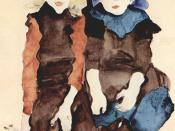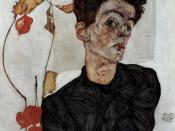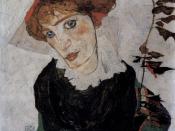Transformation in Art
Many artists have looked to break away from the standard styles of the times, and have achieved their personal visions by creating their own unique styles by opening small art exhibits that broke away from the salon. Two examples that typify this twist on reality can be seen in Egon Schiele's Self-Portrait Nude, where we see a dramatic interpretation on reality. Another example that embodies the dramatic transformation from observed reality to create a personal vision is personified in Fernard Leger's mechanical looking Three Women.
Schiele mostly created erotic paintings, watercolors, and drawings that are somewhat cruel, and narcissistic. His art broke away from the accepted prudish style of the time. Such is the case in his Self-Portrait Nude, in which his use of soft colors are meant to communicate emotions, as well as other deeper meanings rather than record exactly what is seen. Because many of his paintings have sexual overtones, many critics have looked down upon Schiele as vulgar and offensive.
Schiele revealed a deep hesitation toward sexual themes in many of his self-portraits. In this piece, Schiele abstractly depicts an image that suffers from severe physical and psychological endurance. The man is emaciated and his skin appears red and irritated, and is hanging, barely attached to his muscles. His face appears bruised and his arm is abnormally large and distorted in comparison to the rest of his body. Schieles use of what appears almost like one continual line, along with his use of vertical lines create an abstract feeling and the viewer can almost feel the mans pain. Schiele's unique transformation on observed reality made him one of the twentieth centuries most exotic artists.
Another artist who put an interesting twist on observed reality was Fernand Leger, in his piece The Three...


